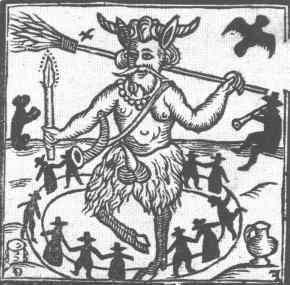Folklore
Robin Goodfellow (Puck), as shown here with cloven hoof, prominent priapism, and a witches' coven, is not exactly the minor mischief-maker of A Midsummer Night's Dream.
Folk festivals were frowned upon by the Church, as remnants of pagan ritual; thus Puck in this picture is given both positive and negative symbolism: fertility, and associations with witchcraft. It is a measure of Shakespeare's skill that he is able to create a world where fairies, though as imperfect* as humans, are largely free from demonic qualities.
Click to read about "ghoulies and ghosties*". . . and a gnome. Or click here to read about how fairies* eventually became "cute".
Shakespeare's Puck
Puck is a master of harmless rustic mischief, almost benevolent in his pursuit of physical fun:
I am that merry wanderer of the night.
I jest to Oberon, and make him smile,
When I a fat and bean-fed horse beguile,
Neighing in likeness of a filly foal:
And sometime lurk I in a gossip's* bowl,
In very likeness of a roasted crab;*
And when she drinks, against her lips I bob
And on her withered dewlap* pour the ale.
The wisest aunt, telling the saddest* tale,
Sometime for three-foot stool mistaketh me;
Then slip I from her bum, down topples she,
And "tailor*" cries, and falls into a cough;
And then the whole quire* hold their hips and laugh,
And waxen* in their mirth, and neeze,* and swear
A merrier hour was never wasted there.
(A Midsummer Night's Dream, 2.1.43-57)
Footnotes
-
As bad as the humans
Titania has a long and impassioned speech to Oberon on the disorder in nature that their quarrel has created.
-
"Things that go bump in the night"
There is a well-known passage in an old Cornish Litany (prayer) that expresses what must have been a common fear of the time:
From ghoulies and ghosties and long-leggedy beasties, and things that go bump in the night, Good Lord deliver us.
Reginald Scot, in his Discoverie of Witchcraft, describes the way children were raised in fear of such supernatural agents:
. . . [parents and teachers] have so frayed [frightened] us with . . . spirits, witches, urchins [goblins that were supposed to take the form of hedgehogs], elves, hags, fairies, satyrs, Pans, fauns, sylens [wood-gods], kit with the can[dle]stick [a will o' the wisp], tritons, centaurs, dwarfs, giants, imps, calcars [magicians], conjurers, nymphs, changelings, incubus [spirits supposed to sleep with women], Robin Goodfellow. . . that we are afraid of our own shadows.
-
Cute and romantic
Shakespeare's creation of Oberon, Titania, and other small supernatural beings in A Midsummer Night's Dream profoundly influenced the way that later writers and artists conceived fairies. From the giant, menacing figure of the Robin Goodfellow pictured in the woodcut, fairies became small and cute; the queen of the fairies romantic and wistful.
-
A Puckish glossary
- gossip's
- Literally godmother's--noted for their chatting at the baptism.
- crab
- Crab-apple.
- dewlap
- Puck is describing the old woman's wrinkled neck in terms usually applied to cattle.
- saddest
- Most solemn.
- tailor
- Not clear: it may be a corruption of the French "taillard" (thief).
- quire
- Or choir--a large group.
- waxen
- Increase (as the moon waxes).
- neeze
- Wheeze and sneeze.
